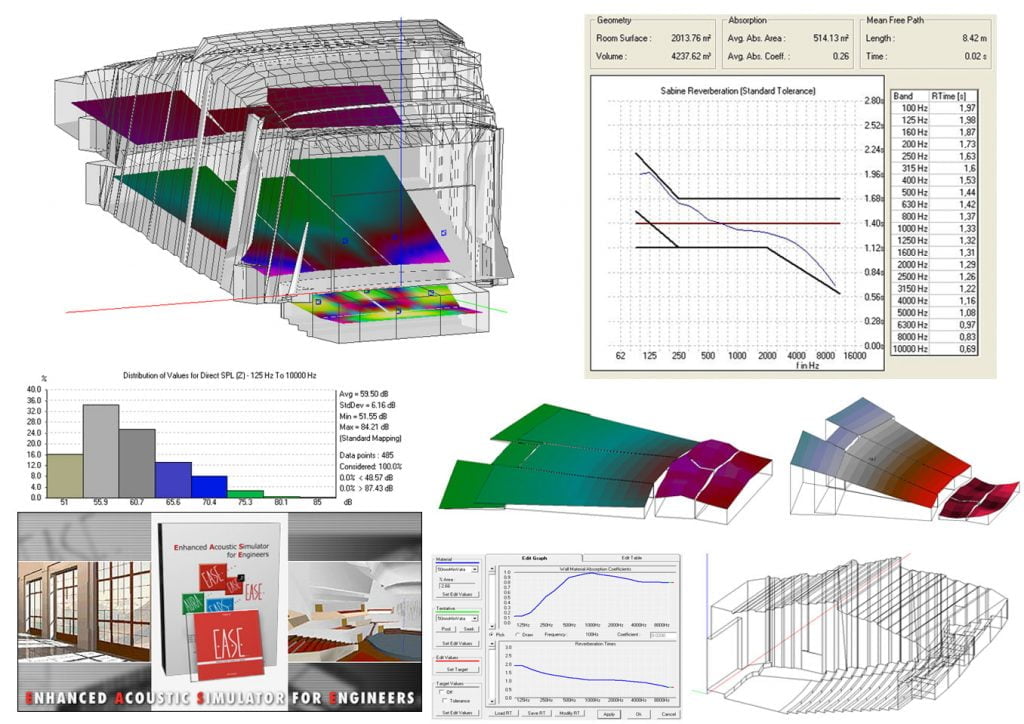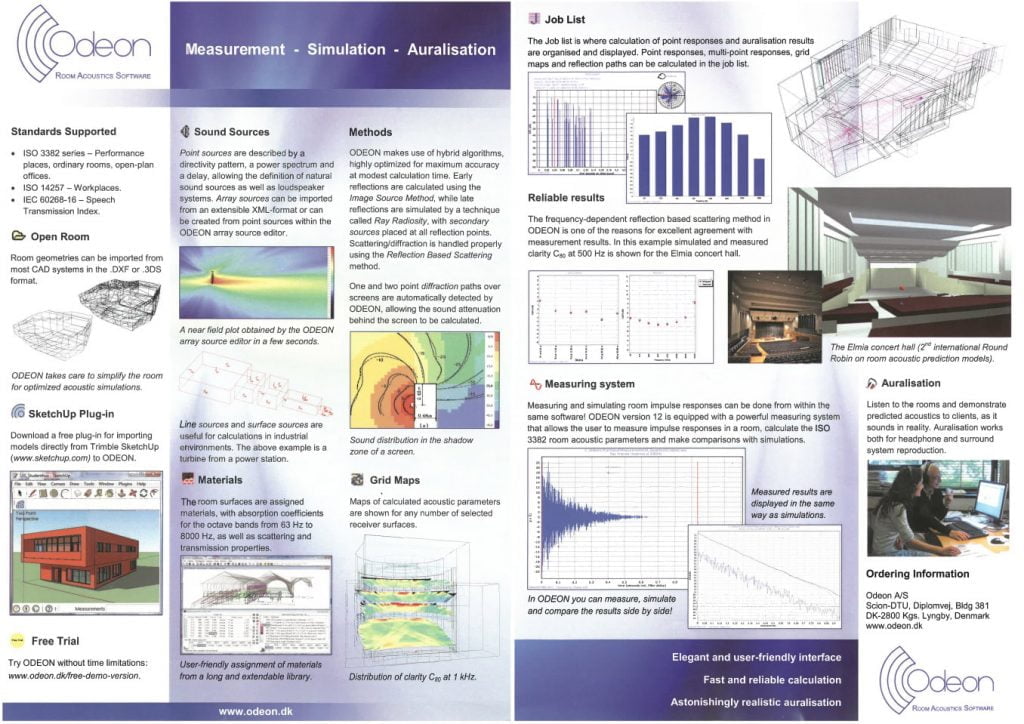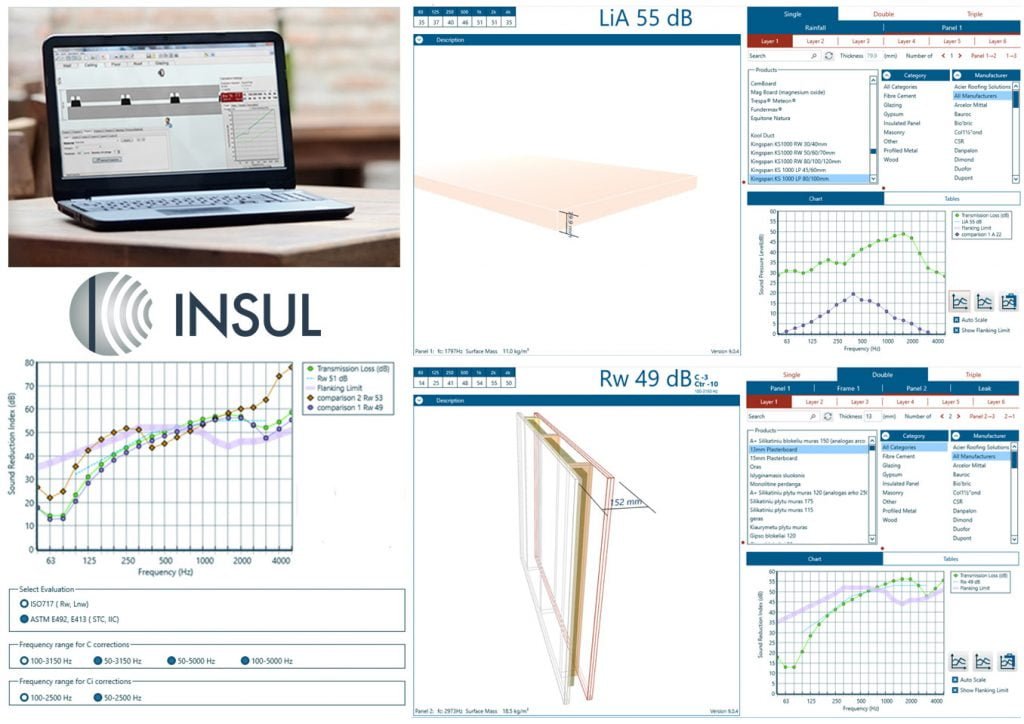We perform architectural acoustics simulations using EASE 4.4 developed by German company AFMG and Odeon Industrial 14.0 produced by Danish company Odeon AS. Calculations are supported by ISO 3382, ISO 14257; IEC 60268-16. Simulation calculations are performed in a spatial model, which fully reflects the shape, materiality and acoustic environment of the analyzed room. The calculations determine the demand for materials and their acoustic characteristics, evaluate the influence of geometry on local acoustics, calculate the main parameters and estimates of architectural acoustics – RT60 (RT20, RT30), G, C50; D50, Ts C80; EDT and other. Comparative calculations are often performed to show the effect of the material substitution on the end result or the adequacy of the technical task. Performing thorough calculations can minimize the need for acoustic materials or maximize performance with the existing ones. In full models, it is possible to simulate the sound of music or language in the projected room, thus ensuring the suitability of the result to the customer at an early stage of the project. In open-plan offices, it is possible to graphically represent noise propagation in common areas and to demonstrate the benefits of acoustic solutions. The calculations combine “INSUL” and “Odeon” software packages to simulate indoor noise dispersion.
SIMULATIONS


We perform computer simulation calculations of noise dispersion using CadnaA software from “DataKustik”. This package is designed to perform calculations, estimations, forecasting and visual presentation of noise dispersion in the environment.
The calculations determine the factual situation of the acoustic environment and assess any possible changes due to increased traffic flows, new buildings or other environmental changes. The calculations are based on the development of a spatial environmental model which can assess road, rail, air and industrial noise sources; buildings, terrain, partial vegetation, noise barriers, bridges and more.
The results are plotted visually as well as graphically, both horizontally and vertically. Calculations are based on CNOSSOS-EU (2014), ISO 9613 and others (see the page on software packages).

We perform simulation calculations of electro-acoustic sound coverage using EASE 4.4 developed by German company AFMG and Odeon Industrial 14.0 produced by Danish company Odeon AS. Calculations are performed by reconstructing the analyzed objects in 3D, specifying the environment of the planned / existing architectural acoustics. The results are presented in graphs and tables also visually on the premises / building surfaces, individual points or areas. Basic evaluation parameters like (STI, RASTI, Direct SPL, Total SPL) smoothness, overlap zones, and others are determined.
We perform computer simulation calculations according to ISO-717; ISO 140-18; ASTM E492; ESTM E413, partially ISO-12354 standards. Calculations are performed on INSUL software developed by Marshall Day Acoustics, a New Zealand company. The calculations determine the possible values of airborne sound insulation of structures, impact sound insulation values, roof noise caused by rain, airborne sound insulation values of glazing units, insulation of the facade structure and possible noise level indoors partly calculating the influence of bypass sound. Calculation reports or calculation data sheet are also provided. The calculations are useful in determining the required insulation of the façade, assessing the influence of individual components on the structures and arguing on the relevance of the selected structures or alterations to the task.

- ARCHITECTURAL ACOUSTICS
We perform architectural acoustics simulations using EASE 4.4 developed by German company AFMG and Odeon Industrial 14.0 produced by Danish company Odeon AS. Calculations are supported by ISO 3382, ISO 14257; IEC 60268-16. Simulation calculations are performed in a spatial model, which fully reflects the shape, materiality and acoustic environment of the analyzed room. The calculations determine the demand for materials and their acoustic characteristics, evaluate the influence of geometry on local acoustics, calculate the main parameters and estimates of architectural acoustics – RT60 (RT20, RT30), G, C50; D50, Ts C80; EDT and other. Comparative calculations are often performed to show the effect of the material substitution on the end result or the adequacy of the technical task. Performing thorough calculations can minimize the need for acoustic materials or maximize performance with the existing ones. In full models, it is possible to simulate the sound of music or language in the projected room, thus ensuring the suitability of the result to the customer at an early stage of the project. In open-plan offices, it is possible to graphically represent noise propagation in common areas and to demonstrate the benefits of acoustic solutions. The calculations combine “INSUL” and “Odeon” software packages to simulate indoor noise dispersion.


- NOISE PROPAGATION
We perform computer simulation calculations of noise dispersion using CadnaA software from “DataKustik”. This package is designed to perform calculations, estimations, forecasting and visual presentation of noise dispersion in the environment.
The calculations determine the factual situation of the acoustic environment and assess any possible changes due to increased traffic flows, new buildings or other environmental changes. The calculations are based on the development of a spatial environmental model which can assess road, rail, air and industrial noise sources; buildings, terrain, partial vegetation, noise barriers, bridges and more.
The results are plotted visually as well as graphically, both horizontally and vertically. Calculations are based on CNOSSOS-EU (2014), ISO 9613 and others (see the page on software packages).
- ELECTRO ACOUSTICS
We perform simulation calculations of electro-acoustic sound coverage using EASE 4.4 developed by German company AFMG and Odeon Industrial 14.0 produced by Danish company Odeon AS. Calculations are performed by reconstructing the analyzed objects in 3D, specifying the environment of the planned / existing architectural acoustics. The results are presented in graphs and tables also visually on the premises / building surfaces, individual points or areas. Basic evaluation parameters like (STI, RASTI, Direct SPL, Total SPL) smoothness, overlap zones, and others are determined.
- SOUND INSULATION
We perform computer simulation calculations according to ISO-717; ISO 140-18; ASTM E492; ESTM E413, partially ISO-12354 standards. Calculations are performed on INSUL software developed by Marshall Day Acoustics, a New Zealand company. The calculations determine the possible values of airborne sound insulation of structures, impact sound insulation values, roof noise caused by rain, airborne sound insulation values of glazing units, insulation of the facade structure and possible noise level indoors partly calculating the influence of bypass sound. Calculation reports or calculation data sheet are also provided. The calculations are useful in determining the required insulation of the façade, assessing the influence of individual components on the structures and arguing on the relevance of the selected structures or alterations to the task.

